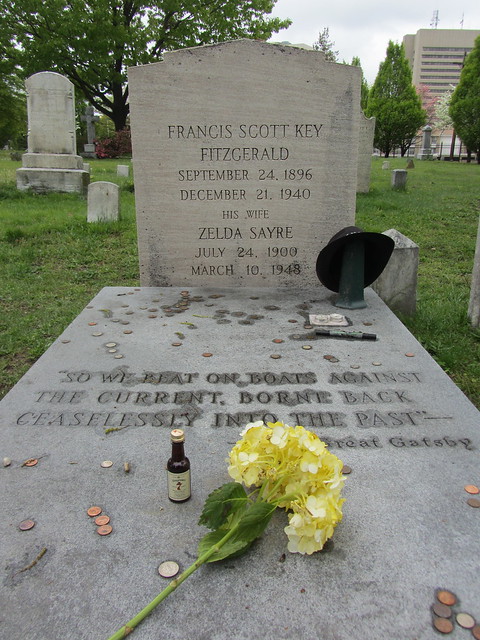F. Scott Fitzgerald is buried in Rockville, MD. You heard that right. Francis Scott Fitzgerald, author of The Great Gatsby and This Side of Paradise and one of the seminal American writers of the 20th century, is not buried in Paris, or New York, or Los Angeles, or even Princeton, but rests next to his wife, Zelda, and his daughter, Scottie, in a small, forgotten graveyard nestled between a thoroughfare and a train track in Rockville, MD.
The story of how he wound up there goes like this. Fitzgerald’s family had a long-standing history in the area. His father, Edward, grew up in Montgomery County, and F. Scott would often visit his Aunt, who lived near Rockville, as a child. He was named after Maryland’s own Francis Scott Key, composer of “The Star-Spangled Banner” and a direct relative of his somewhere along the cousin spectrum. His father was buried in the family plot at St. Mary’s Church in Rockville, and by all accounts, that’s where F. Scott always planned to be buried. Yet, his connection to the city, and the state of Maryland, was significantly more ancestral than biographical. The only place Fitzgerald actually lived in Maryland was Towson, 50 miles from Rockville, where he rented a house to be by his wife’s side as she underwent psychiatric treatment, presumably for schizophrenia, at Johns Hopkins Hospital in the early 30’s.
When Fitzgerald died of a heart attack in 1940, at the age of 44, he was living in Los Angeles with a woman who wasn’t his wife, and had largely slipped out of the public eye. His last novel, Tender Is the Night, had been met with a mixed reception when it was published in 1934, and his new work, The Last Tycoon or The Love of the Last Tycoon, remained unfinished. Alcoholism, exhibitionism, and a generally provocative lifestyle were the traits commonly associated with his name.
This, in combination with his marriage to Zelda, a Protestant, and his self-acknowledged distancing from Catholicism, led the church to deny the Fitzgerald family’s request for F. Scott to be buried in the plot at St. Mary’s. Instead, when the body arrived from California, it was laid to rest at the Rockville Cemetery, a mile away, on a rainy day with little fanfare and only 20 or so people in attendance. 8 years later, when Zelda died, she was buried alongside her husband.
In 1975, after 35 years and a great deal of lobbying, the Catholic Church finally accepted the petition to have Francis and Zelda’s bodies re-interred at St. Mary’s Church, and they’ve remained there, largely unnoticed, ever since. Fitzgerald’s fame, critical reputation, and pop cultural status have been wholly restored, and most Americans with a high school diploma have read at least The Great Gatsby, but few Washingtonians have visited F. Scott’s gravesite, or even realize that it’s there.
Part of that can be attributed to location. I visited St. Mary’s and, while pretty, it’s not a destination in it’s own right. If F. Scott was buried at a place like Arlington National, he might be receiving scores of visitors each day. But I also see it as an indication of our tendency to worship characters over real people. F. Scott was a complicated individual with an untidy biography, and while a great historical character like Ernest Hemingway will be worshipped for years to come, much more so than his literary avatars Jake Barnes or Robert Jordan, it’s Jay Gatsby, the superior character, who will live on in an eternity of recognition, not Francis Scott Fitzgerald.
With Baz Luhmann’s The Great Gatsby only days from hitting theaters and interest in the book reinvigorated, now would be a great time to pay a visit the author’s grave. The St. Mary’s Cemetery is only a half-mile walk from the Rockville metro station, and there’s parking for those who drive behind the old church building. You’ll see these signs on a few lampposts when you approach the entrance to St. Mary’s from Rockville Pike.
It’s a quietly upheld custom to bring F. Scott a small bottle of liquor in addition to flowers. Don’t be surprised if you’re the only one there, as I was when I visited. It was a strange experience for me, and by no means a grand one, with cars whirring by glass buildings on one side, and trains chugging past on the other, but it was a trip I was glad to have made. I count more than one of his works among my personal favorites, and was happy to have paid a moment of respect to the literary tycoon sleeping eternally on Washington’s doorstep.
[googlemaps https://maps.google.com/maps?client=safari&oe=UTF-8&ie=UTF8&q=St.+Mary’s+Church,+Rockville+MD&fb=1&gl=us&hq=St.+Mary’s+Church,+Rockville+MD&hnear=St.+Mary’s+Church,+Rockville+MD&cid=0,0,7578321840798921550&t=m&ll=39.082922,-77.143378&spn=0.00583,0.013947&z=16&output=embed&w=650&h=350]
P.S. If you’re a taphophile (I can’t believe that word actually exists), or a “tombstone tourist” (as Wikipedia calls it), the cemetery where F. Scott was originally buried is just up the road. The Rockville Cemetery dates to 1738, is actually far larger and more beautiful than St. Mary’s, and is the final resting place of baseball legend Walter Johnson.

Wow, who knew? Very cool discovery!
Now here is a little trivia… Princess Zelda (from the videogame The Legend of Zelda) was actually named after Zelda Sayre….
It was one of the first sites my aunt & uncle showed me when I moved to DC in 1980. They lived in Rockville and were quite proud of F Scott’s presence there.